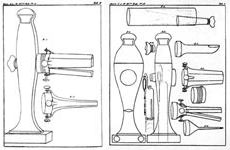|
Bile Acid Diarrhea
Bile acid malabsorption (BAM), known also as bile acid diarrhea, is a cause of several gut-related problems, the main one being chronic diarrhea. It has also been called bile acid-induced diarrhea, cholerheic or choleretic enteropathy, bile salt diarrhea or bile salt malabsorption. It can result from malabsorption secondary to gastrointestinal disease, or be a primary disorder, associated with excessive bile acid production. Treatment with bile acid sequestrants is often effective. Depending on the severity of symptoms, it may be recognised as a disability in the United Kingdom under the Equality Act 2010. Signs and symptoms A persistent (chronic) history of diarrhea, with watery or mushy, unformed stools, (types 6 and 7 on the Bristol stool scale), sometimes with steatorrhea, increased frequency and urgency of defecation are common manifestations, often with fecal incontinence and other gastrointestinal symptoms such as abdominal swelling, bloating and abdominal pain. People wi ... [...More Info...] [...Related Items...] OR: [Wikipedia] [Google] [Baidu] |
Gastroenterology
Gastroenterology (from the Greek gastḗr- "belly", -énteron "intestine", and -logía "study of") is the branch of medicine focused on the digestive system and its disorders. The digestive system consists of the gastrointestinal tract, sometimes referred to as the ''GI tract,'' which includes the esophagus, stomach, small intestine and large intestine as well as the accessory organs of digestion which include the pancreas, gallbladder, and liver. The digestive system functions to move material through the GI tract via peristalsis, break down that material via digestion, absorb nutrients for use throughout the body, and remove waste from the body via defecation. Physicians who specialize in the medical specialty of gastroenterology are called gastroenterologists or sometimes ''GI doctors''. Some of the most common conditions managed by gastroenterologists include gastroesophageal reflux disease, gastrointestinal bleeding, irritable bowel syndrome, inflammatory bowel disease (IBD ... [...More Info...] [...Related Items...] OR: [Wikipedia] [Google] [Baidu] |
Fecal Incontinence
Fecal incontinence (FI), or in some forms, encopresis, is a lack of control over defecation, leading to involuntary loss of bowel contents—including flatus (gas), liquid stool elements and mucus, or solid feces. FI is a sign or a symptom, not a diagnosis. Incontinence can result from different causes and might occur with either constipation or diarrhea. Continence is maintained by several interrelated factors, including the anal sampling mechanism, and incontinence usually results from a deficiency of multiple mechanisms. The most common causes are thought to be immediate or delayed damage from childbirth, complications from prior anorectal surgery (especially involving the anal sphincters or hemorrhoidal vascular cushions), altered bowel habits (e.g., caused by irritable bowel syndrome, Crohn's disease, ulcerative colitis, food intolerance, or constipation with overflow incontinence). Reported prevalence figures vary: an estimated 2.2% of community-dwelling adult ... [...More Info...] [...Related Items...] OR: [Wikipedia] [Google] [Baidu] |
Gallbladder
In vertebrates, the gallbladder, also known as the cholecyst, is a small hollow Organ (anatomy), organ where bile is stored and concentrated before it is released into the small intestine. In humans, the pear-shaped gallbladder lies beneath the liver, although the structure and position of the gallbladder can vary significantly among animal species. It receives bile, produced by the liver, via the common hepatic duct, and stores it. The bile is then released via the common bile duct into the duodenum, where the bile helps in the digestion of fats. The gallbladder can be affected by gallstones, formed by material that cannot be dissolved – usually cholesterol or bilirubin, a product of hemoglobin breakdown. These may cause significant pain, particularly in the upper-right corner of the abdomen, and are often treated with removal of the gallbladder (called a cholecystectomy). Cholecystitis, inflammation of the gallbladder, has a wide range of causes, including result from the ... [...More Info...] [...Related Items...] OR: [Wikipedia] [Google] [Baidu] |
Biliary System
The biliary tract (also biliary tree or biliary system) refers to the liver, gallbladder and bile ducts, and how they work together to make, store and secrete bile. Bile consists of water, electrolytes, bile acids, cholesterol, phospholipids and conjugated bilirubin. Some components are synthesized by hepatocytes (liver cells); the rest are extracted from the blood by the liver. Bile is secreted by the liver into small ducts that join to form the common hepatic duct. Between meals, secreted bile is stored in the gallbladder. During a meal, the bile is secreted into the duodenum (part of the small intestine) to rid the body of waste stored in the bile as well as aid in the absorption of dietary fats and oils. Structure The biliary tract refers to the path by which bile is secreted by the liver then transported to the duodenum, the first part of the small intestine. A structure common to most members of the mammal family, the biliary tract is often referred to as a tree becau ... [...More Info...] [...Related Items...] OR: [Wikipedia] [Google] [Baidu] |
Liver
The liver is a major metabolic organ (anatomy), organ exclusively found in vertebrates, which performs many essential biological Function (biology), functions such as detoxification of the organism, and the Protein biosynthesis, synthesis of various proteins and various other Biochemistry, biochemicals necessary for digestion and growth. In humans, it is located in the quadrants and regions of abdomen, right upper quadrant of the abdomen, below the thoracic diaphragm, diaphragm and mostly shielded by the lower right rib cage. Its other metabolic roles include carbohydrate metabolism, the production of a number of hormones, conversion and storage of nutrients such as glucose and glycogen, and the decomposition of red blood cells. Anatomical and medical terminology often use the prefix List of medical roots, suffixes and prefixes#H, ''hepat-'' from ἡπατο-, from the Greek language, Greek word for liver, such as hepatology, and hepatitis The liver is also an accessory digestive ... [...More Info...] [...Related Items...] OR: [Wikipedia] [Google] [Baidu] |
Bile Salts
Bile acids are steroid acids found predominantly in the bile of mammals and other vertebrates. Diverse bile acids are synthesized in the liver in peroxisomes. Bile acids are conjugated with taurine or glycine residues to give anions called bile salts. Primary bile acids are those synthesized by the liver. Secondary bile acids result from bacterial actions in the colon (anatomy), colon. In humans, taurocholic acid and glycocholic acid (derivatives of cholic acid) and taurochenodeoxycholic acid and glycochenodeoxycholic acid (derivatives of chenodeoxycholic acid) are the major bile salts. The salts of their 7-alpha-dehydroxylated derivatives, deoxycholic acid and lithocholic acid, are also found, with derivatives of cholic, chenodeoxycholic and deoxycholic acids accounting for over 90% of human biliary bile acids. Description Bile acids comprise about 80% of the organic compounds in bile (others are phospholipids and cholesterol). An increased secretion of bile acids produces an ... [...More Info...] [...Related Items...] OR: [Wikipedia] [Google] [Baidu] |
Depression (mood)
Depression is a mental state of low Mood (psychology), mood and aversion to activity. It affects about 3.5% of the global population, or about 280 million people worldwide, as of 2020. Depression affects a person's thoughts, behavior, feelings, and subjective well-being, sense of well-being. The pleasure or joy that a person gets from certain experiences is reduced, and the afflicted person often experiences a loss of motivation or interest in those activities. People with depression may experience sadness, feelings of dejection or hopelessness, difficulty in thinking and concentration, or a significant change in appetite or time spent sleeping; Suicidal ideation, suicidal thoughts can also be experienced. Depression can have multiple, sometimes overlapping, origins. Depression can be a symptom of some mood disorders, some of which are also commonly called ''depression'', such as major depressive disorder, bipolar disorder and dysthymia. Additionally, depression can be a norm ... [...More Info...] [...Related Items...] OR: [Wikipedia] [Google] [Baidu] |
Anxiety
Anxiety is an emotion characterised by an unpleasant state of inner wikt:turmoil, turmoil and includes feelings of dread over Anticipation, anticipated events. Anxiety is different from fear in that fear is defined as the emotional response to a present threat, whereas anxiety is the anticipation of a future one. It is often accompanied by nervous behavior such as pacing back and forth, Somatic anxiety, somatic complaints, and Rumination (psychology), rumination. Anxiety is a feeling of uneasiness and worry, usually generalized and unfocused as an overreaction to a situation that is only subjectively seen as menacing. It is often accompanied by muscular tension, restlessness, Fatigue (medical), fatigue, inability to catch one's breath, tightness in the abdominal region, nausea, and problems in concentration. Anxiety is closely related to fear, which is a response to a real or perceived immediate threat (fight-or-flight response); anxiety involves the expectation of a future t ... [...More Info...] [...Related Items...] OR: [Wikipedia] [Google] [Baidu] |
Dizziness
Dizziness is an imprecise term that can refer to a sense of disorientation in space, vertigo, or lightheadedness. It can also refer to Balance disorder, disequilibrium or a non-specific feeling, such as giddiness or foolishness. Dizziness is a common medical complaint, affecting 20–30% of persons. Dizziness is broken down into four main subtypes: vertigo (~25–50%), equilibrioception#Dysfunction, disequilibrium (less than ~15%), presyncope (less than ~15%), and nonspecific dizziness (~10%). * Vertigo is the sensation of spinning or having one's surroundings spin about them. Many people find vertigo very disturbing and often report associated nausea and vomiting. * Presyncope describes lightheadedness or feeling faint; the name relates to Syncope (medicine), syncope, which is actually fainting. * equilibrioception#Dysfunction, Disequilibrium is the sensation of being off balance and is most often characterized by frequent falls in a specific direction. This condition is not of ... [...More Info...] [...Related Items...] OR: [Wikipedia] [Google] [Baidu] |
Fatigue
Fatigue is a state of tiredness (which is not sleepiness), exhaustion or loss of energy. It is a signs and symptoms, symptom of any of various diseases; it is not a disease in itself. Fatigue (in the medical sense) is sometimes associated with medical conditions including autoimmune disease, organ failure, chronic pain conditions, mood disorders, heart disease, infectious diseases, and post-infectious-disease states. However, fatigue is complex and in up to a third of primary care cases no medical or psychiatric diagnosis is found. Fatigue (in the general usage sense of normal tiredness) often follows prolonged physical or mental activity. Physical fatigue results from muscle fatigue brought about by intense physical activity. Mental fatigue results from prolonged periods of Cognition, cognitive activity which impairs cognitive ability, can manifest as sleepiness, lethargy, or directed attention fatigue, and can also impair physical performance. Definition Fatigue in a medica ... [...More Info...] [...Related Items...] OR: [Wikipedia] [Google] [Baidu] |
Well-being
Well-being is what is Intrinsic value (ethics), ultimately good for a person. Also called "welfare" and "quality of life", it is a measure of how well life is going for someone. It is a central goal of many individual and societal endeavors. Subjective well-being refers to how a person feels about and evaluates their life. Objective well-being encompasses factors that can be assessed from an external perspective, such as health, income, and security. Individual well-being concerns the quality of life of a particular person, whereas community well-being measures how well a group of people functions and thrives. Various types of well-being are categorized based on the domain of life to which they belong, such as physical, psychological, emotional, social, and economic well-being. Theories of well-being aim to identify the Essence, essential features of well-being. Hedonism argues that the balance of pleasure over pain is the only factor. Desire theories assert that the satisfact ... [...More Info...] [...Related Items...] OR: [Wikipedia] [Google] [Baidu] |





